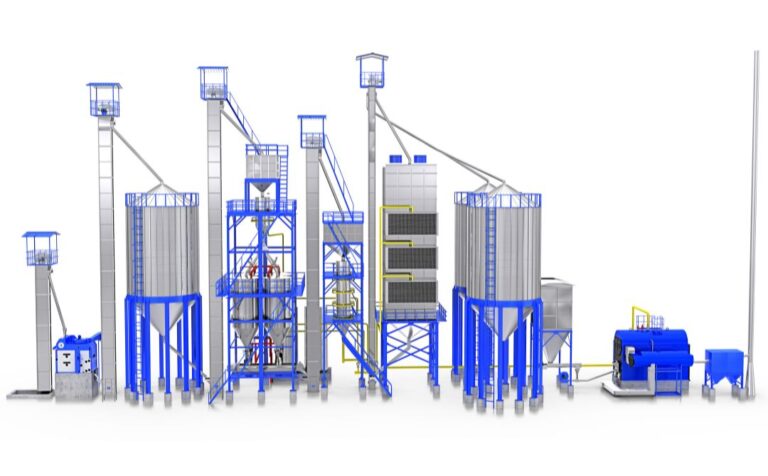Table of Contents
Rice production fuels both local sustenance and global trade. As the world’s largest rice exporter, shipping 24.5 million tonnes in 2024-25, India’s parboiled rice production meets soaring demand, valued at ₹83,000 crore annually.
A paddy parboiling plant transforms raw paddy into high-quality, nutrient-rich rice, offering millers, entrepreneurs, and farmers a lucrative opportunity to tap into rice market. Investing in a paddy processing unit can yield profits of ₹50 lakh-₹5 crore yearly while enhancing grain quality and sustainability.
This blog explores why invest in a paddy parboiling plant, highlights how a parboiling plant improves rice quality and yield, and provides actionable steps to maximize the profitability of paddy parboiling process with cutting-edge solutions from SKF Elixer.
The Rising Demand for Parboiled Rice in India and Beyond
India’s rice industry processes 147 million tonnes of paddy annually, with parboiled rice accounting for 7-8 million tonnes of exports to Africa, the Middle East, and beyond. However, outdated milling practices lead to 5-10% grain losses, costing ₹50,000-₹2 lakh per 100 tonnes, while high energy costs (₹1-2 lakh per 100 tonnes) strain margins.
A paddy parboiling plant modernizes paddy processing, achieving 70-75% head rice yield and meeting FSSAI standards, saving ₹50,000-₹5 lakh per 100 tonnes. For millers and investors, understanding the benefits of starting a parboiled rice unit unlocks a pathway to profitability in the rice processing industry. Let’s dive into the top 5 reasons to invest in a parboiling plant.
- Improved Rice Quality and Yield
How a parboiling plant improves rice quality and yield: Parboiling (soaking, steaming, and drying) hardens grains, reducing breakage during milling to achieve 70-75% head rice yield (vs. 65-70% for raw rice). This boosts market value. - Enhanced Nutritional Value
Parboiling drives nutrients like B vitamins and iron into the grain, retaining 90-95% (vs. 80-85% in raw rice), appealing to health-conscious markets like Europe and the US. - Longer Shelf Life
Parboiled rice lasts 18-24 months (vs. 12-18 months for raw), reducing spoilage losses by 5-10%, saving ₹50,000-₹1 lakh per 100 tonnes. - Cost Efficiency and ROI
ROI from paddy processing business: Modern parboiling plants use energy-efficient systems (200-300 kWh/100 tonnes), cutting costs by 20-30%. A 100-tonne/day plant achieves ROI in 2-3 years. - Global Market Demand
Parboiled rice exports grew 14% CAGR (2017-21), with demand in Africa and the Middle East for varieties like IR 64 (₹60-100/kg).
These reasons highlight the profitability of paddy parboiling process.
How a Parboiling Plant Works
A paddy processing unit follows a streamlined process:
- Soaking: Paddy is soaked in hot water (50-60°C, 6-12 hours) to 24-30% moisture, using tanks.
- Steaming: Steamed at 100-120°C for 20-30 minutes with automated sieves gelatinizing starch.
- Drying: Hot air dryers reduce moisture to 12-14%, ensuring pale yellow grains.
- Milling: Modern mills dehusk and polish, achieving 70-75% yield.
- Monitoring: IoT sensors track temperature and moisture for consistency.
Challenges and Solutions
A paddy processing unit follows a streamlined process:
- Soaking: Paddy is soaked in hot water (50-60°C, 6-12 hours) to 24-30% moisture, using tanks.
- Steaming: Steamed at 100-120°C for 20-30 minutes with automated sieves gelatinizing starch.
- Drying: Hot air dryers reduce moisture to 12-14%, ensuring pale yellow grains.
- Milling: Modern mills dehusk and polish, achieving 70-75% yield.
- Monitoring: IoT sensors track temperature and moisture for consistency.
Benefits of Starting a Parboiled Rice Unit
- Higher Profits: 10-20% price premium (₹60-150/kg) yields ₹50 lakh-₹5 crore annually for 1,000 tonnes.
- Export Opportunities: Meets demand in 120+ countries, securing ₹1-10 crore contracts.
- Sustainability: Reduces spoilage and wastewater with modern systems, aligning with Swachh Bharat.
- Scalability: Starts at 10 tonnes/day, scaling to 100 tonnes/day.
Steps to Invest in a Paddy Parboiling Plant
Ready for parboiling plant investment? Follow these steps:
- Assess Demand: Target export markets (Africa, Middle East) for IR 64 or Sona Masoori (₹60-150/kg).
- Choose Capacity: Select 10-100 tonne/day paddy parboiling plant.
- Budget: Plan ₹10-100 lakh setup, ₹1-5 lakh yearly maintenance.
- Select Vendor: Partner with BIS-certified SKF Elixer for paddy processing unit.
- Integrate Technology: Use IoT dryers and sieves for efficiency.
- Secure Certifications: Obtain FSSAI/ISO for exports.
Conclusion
Investing in a paddy parboiling plant is a strategic move for Indian millers, unlocking the benefits of starting a parboiled rice unit with higher yields, nutrition, and profits of ₹50 lakh-₹5 crore yearly. By addressing why invest in a paddy parboiling plant, millers meet global demand while overcoming energy and water challenges.
SKF Elixer India Pvt. Ltd. offers advanced paddy processing plants, ensuring 70-75% head rice yield and CPCB-compliant wastewater management. Contact SKF Elixer today to maximize the ROI from paddy processing business and thrive in the rice processing industry.
FAQs
Q1: Why invest in a paddy parboiling plant?
Enhances rice quality, yields 70-75% head rice, boosts profits by ₹50 lakh-₹5 crore yearly, and meets global demand.
Q2: How does a parboiling plant improve rice quality and yield?
Soaking, steaming, and drying harden grains, reducing breakage and achieving 70-75% yield, worth ₹60-150/kg.
Q3: What are the benefits of starting a parboiled rice unit?
Higher profits, export potential, longer shelf life (18-24 months), and sustainability.
Q4: What is the ROI from paddy processing business?
A parboiling plant achieves ROI in 2-3 years, saving ₹1-5 lakh per 100 tonnes with 10-20% price premiums.
Q5: What is the profitability of paddy parboiling process?
Yields ₹50 lakh-₹5 crore yearly for 1,000 tonnes, with energy-efficient systems saving ₹50,000-₹2 lakh per 100 tonnes.
Good reads are meant to be shared









